Page 287 of 467
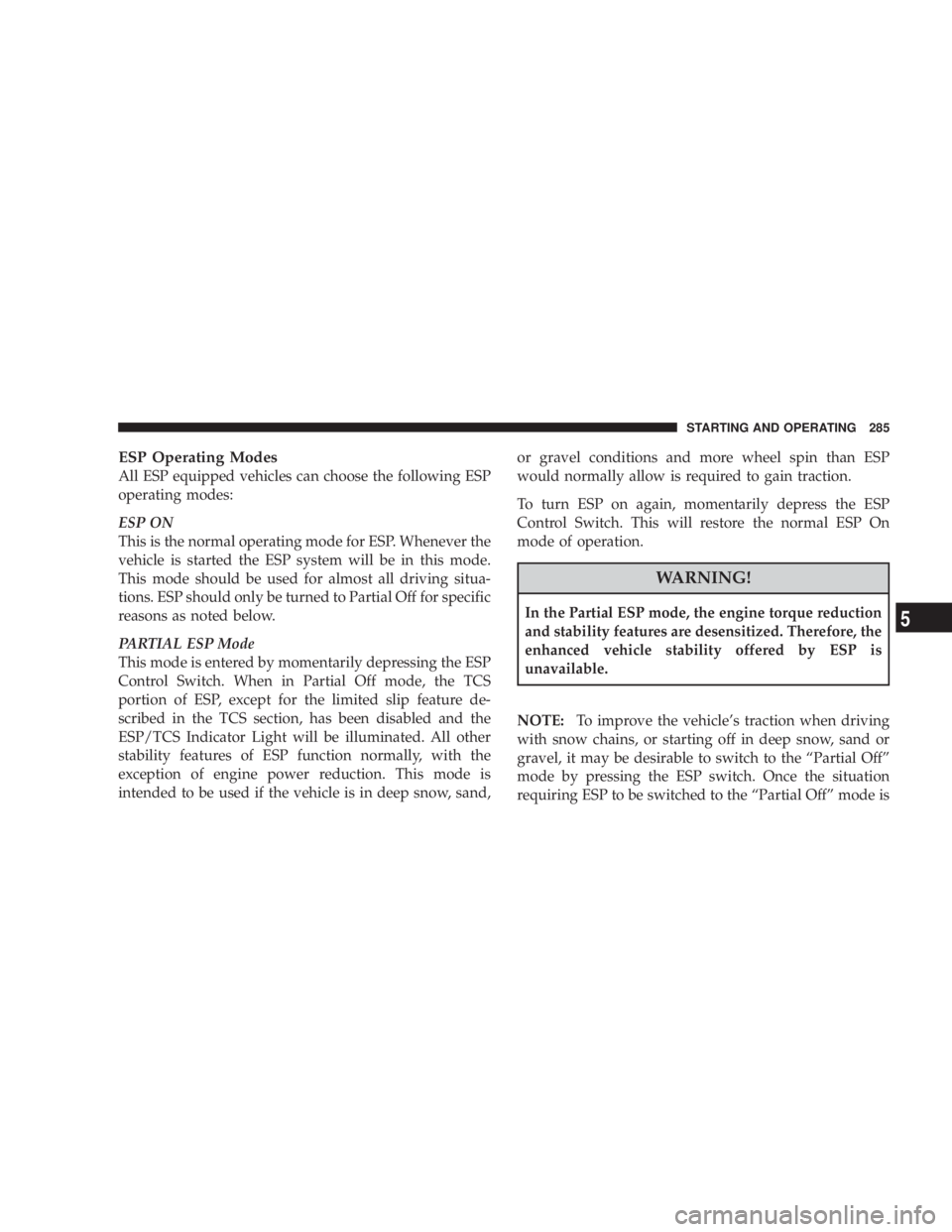
ESP Operating Modes
All ESP equipped vehicles can choose the following ESP
operating modes:
ESP ON
This is the normal operating mode for ESP. Whenever the
vehicle is started the ESP system will be in this mode.
This mode should be used for almost all driving situa-
tions. ESP should only be turned to Partial Off for specific
reasons as noted below.
PARTIAL ESP Mode
This mode is entered by momentarily depressing the ESP
Control Switch. When in Partial Off mode, the TCS
portion of ESP, except for the limited slip feature de-
scribed in the TCS section, has been disabled and the
ESP/TCS Indicator Light will be illuminated. All other
stability features of ESP function normally, with the
exception of engine power reduction. This mode is
intended to be used if the vehicle is in deep snow, sand, or gravel conditions and more wheel spin than ESP
would normally allow is required to gain traction.
To turn ESP on again, momentarily depress the ESP
Control Switch. This will restore the normal ESP On
mode of operation.
WARNING!In the Partial ESP mode, the engine torque reduction
and stability features are desensitized. Therefore, the
enhanced vehicle stability offered by ESP is
unavailable.
NOTE: To improve the vehicle's traction when driving
with snow chains, or starting off in deep snow, sand or
gravel, it may be desirable to switch to the ªPartial Offº
mode by pressing the ESP switch. Once the situation
requiring ESP to be switched to the ªPartial Offº mode is STARTING AND OPERATING 285
5
Page 288 of 467

overcome, turn ESP on again by momentarily depressing
the ªESP Control Switch.º This may be done while the
vehicle is in motion.
ESP/BAS Warning Light and ESP/TCS Indicator
Light
The malfunction indicator for the ESP is com-
bined with the BAS indicator. The yellow ESP/
BAS Warning Light and the yellow ESP/TCS
Indicator Light in the instrument cluster both
come on when the ignition switch is turned to the ON
position. They should both go out with the engine
running. If the ESP/BAS Warning Light comes on con-
tinuously with the engine running, a malfunction has
been detected in either the ESP or BAS system, or both. If
this light remains on after several ignition cycles, and the
vehicle has been driven several miles (kilometers) at
speeds greater than 30 mph (48 km/h), see your autho-
rized dealer as soon as possible to have the problem
diagnosed and corrected. NOTE:
² The ESP Indicator Light and the ESP/BAS Warning
Light come on momentarily each time the ignition
switch is turned ON.
² Each time the ignition is turned ON, the ESP System
will be ON even if it was turned off previously.
² The ESP Control System will make buzzing or clicking
sounds when it is active. This is normal; the sounds
will stop when ESP becomes inactive following the
maneuver that caused the ESP activation.286 STARTING AND OPERATING
Page 292 of 467

CAUTION!² Driving through standing water may cause dam-
age to your vehicle's drivetrain components. Al-
ways inspect your vehicle's fluids (i.e., engine oil,
transmission, axle, etc.) for signs of contamination
(i.e., fluid that is milky or foamy in appearance)
after driving through standing water. Do not con-
tinue to operate the vehicle if any fluid appears
contaminated, as this may result in further dam-
age. Such damage is not covered by the New
Vehicle Limited Warranty.
² Getting water inside your vehicle's engine can
cause it to lock up and stall out, and cause serious
internal damage to the engine. Such damage is not
covered by the New Vehicle Limited Warranty. WARNING!² Driving through standing water limits your vehi-
cle's traction capabilities. Do not exceed 5 mph (8
km/h) when driving through standing water.
² Driving through standing water limits your vehi-
cle's braking capabilities, which increases stop-
ping distances. Therefore, after driving through
standing water, drive slowly and lightly press on
the brake pedal several times to dry the brakes.
² Getting water inside your vehicle's engine can
cause it to lock up and stall out, and leave you
stranded.
² Failure to follow these warnings may result in
injuries that are serious or fatal to you, your
passengers, and others around you.290 STARTING AND OPERATING
Page 305 of 467
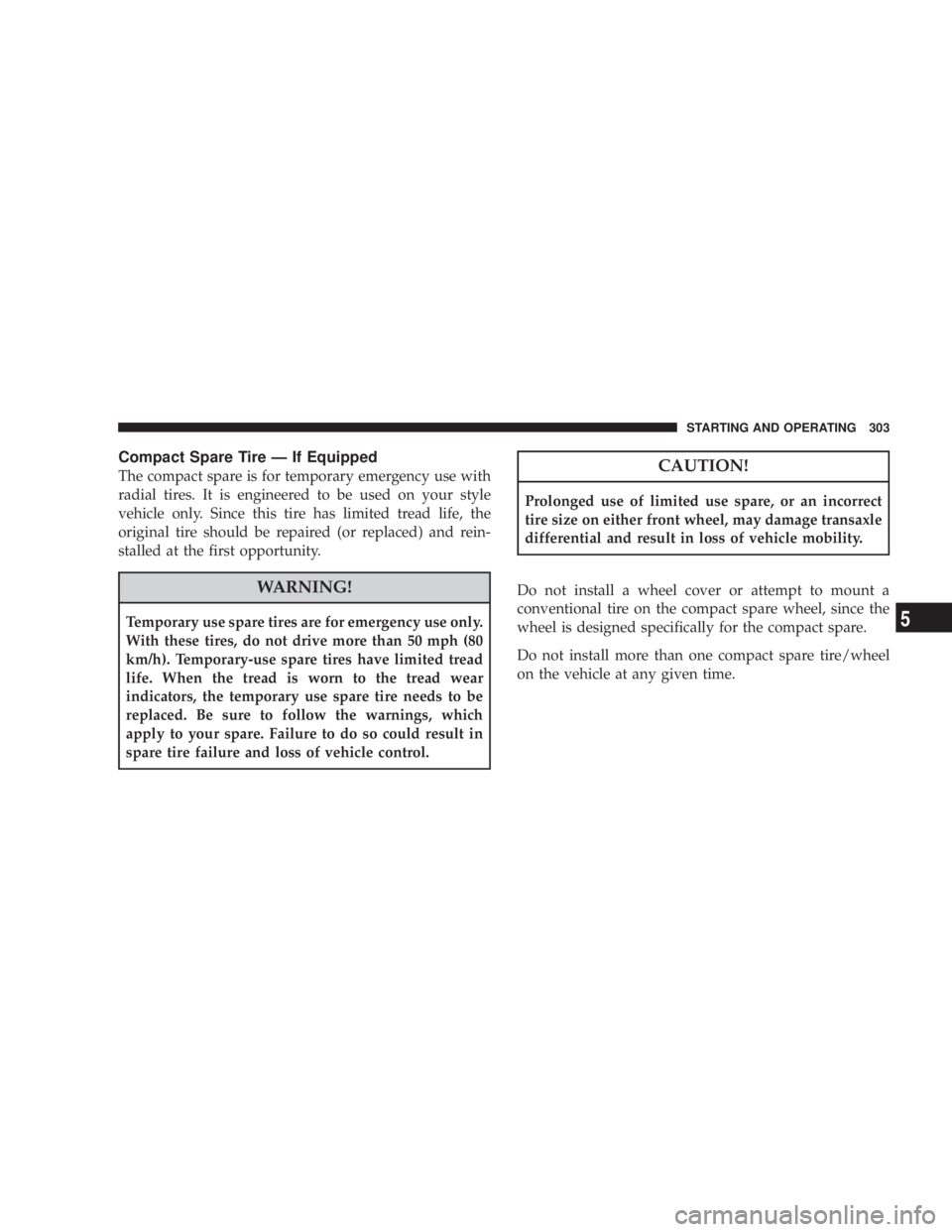
Compact Spare Tire Ð If Equipped
The compact spare is for temporary emergency use with
radial tires. It is engineered to be used on your style
vehicle only. Since this tire has limited tread life, the
original tire should be repaired (or replaced) and rein-
stalled at the first opportunity.
WARNING!Temporary use spare tires are for emergency use only.
With these tires, do not drive more than 50 mph (80
km/h). Temporary-use spare tires have limited tread
life. When the tread is worn to the tread wear
indicators, the temporary use spare tire needs to be
replaced. Be sure to follow the warnings, which
apply to your spare. Failure to do so could result in
spare tire failure and loss of vehicle control. CAUTION!Prolonged use of limited use spare, or an incorrect
tire size on either front wheel, may damage transaxle
differential and result in loss of vehicle mobility.
Do not install a wheel cover or attempt to mount a
conventional tire on the compact spare wheel, since the
wheel is designed specifically for the compact spare.
Do not install more than one compact spare tire/wheel
on the vehicle at any given time. STARTING AND OPERATING 303
5
Page 321 of 467

5. Once you repair or replace the original road tire, and
reinstall it on the vehicle in place of the compact spare,
the TPMS will update automatically. In addition, the
TPM Telltale Light will turn OFF and the graphic in the
EVIC will display a new pressure value instead of dashes
(- -), as long no tire pressure is below the low-pressure
warning limit in any of the four active road tires. The
vehicle may need to be driven for up to 10 minutes above
15 mph (25 km/h) in order for the TPMS to receive this
information.
GENERAL INFORMATION
This device complies with part 15 of the FCC rules and
RSS 210 of Industry Canada. Operation is subject to the
following conditions:
² This device may not cause harmful interference.
² This device must accept any interference received,
including interference that may cause undesired op-
eration. The tire pressure sensors are covered under one of the
following licenses:
United States ..................... KR5S120123
Canada ........................ 2671-S120123
FUEL REQUIREMENTS
2.4L AND 2.7L ENGINES
2.4L and 2.7L engines are designed to meet
all emission regulations and provide excel-
lent fuel economy and performance when
using high quality unleaded ªregularº
gasolines having an octane rating of 87.
The use of premium gasoline is not recom-
mended. Under normal conditions, the use of premium
gasoline will not provide a benefit over high quality
unleaded ªregularº gasolines, and in some circumstances
may result in poorer performance. STARTING AND OPERATING 319
5
Page 322 of 467
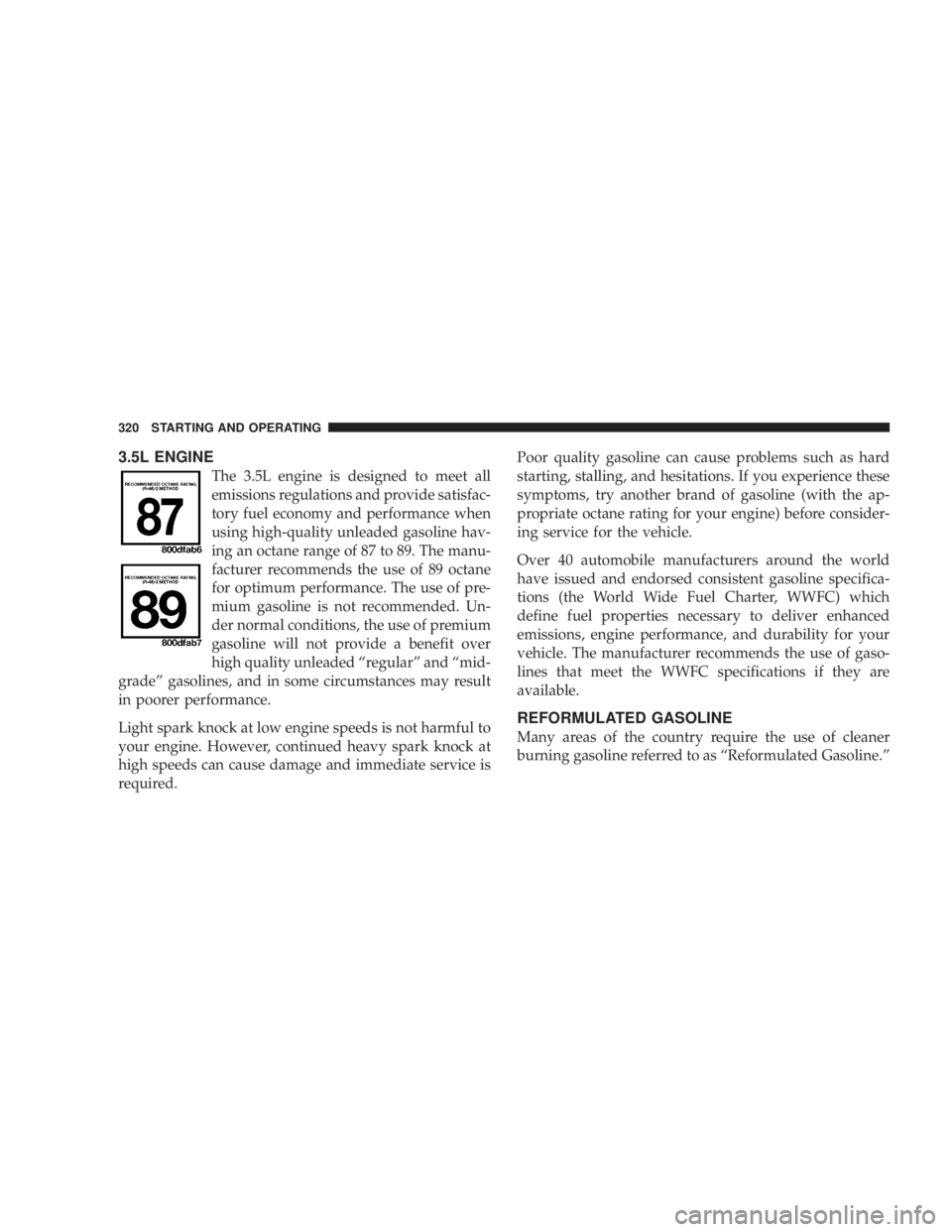
3.5L ENGINE
The 3.5L engine is designed to meet all
emissions regulations and provide satisfac-
tory fuel economy and performance when
using high-quality unleaded gasoline hav-
ing an octane range of 87 to 89. The manu-
facturer recommends the use of 89 octane
for optimum performance. The use of pre-
mium gasoline is not recommended. Un-
der normal conditions, the use of premium
gasoline will not provide a benefit over
high quality unleaded ªregularº and ªmid-
gradeº gasolines, and in some circumstances may result
in poorer performance.
Light spark knock at low engine speeds is not harmful to
your engine. However, continued heavy spark knock at
high speeds can cause damage and immediate service is
required. Poor quality gasoline can cause problems such as hard
starting, stalling, and hesitations. If you experience these
symptoms, try another brand of gasoline (with the ap-
propriate octane rating for your engine) before consider-
ing service for the vehicle.
Over 40 automobile manufacturers around the world
have issued and endorsed consistent gasoline specifica-
tions (the World Wide Fuel Charter, WWFC) which
define fuel properties necessary to deliver enhanced
emissions, engine performance, and durability for your
vehicle. The manufacturer recommends the use of gaso-
lines that meet the WWFC specifications if they are
available.
REFORMULATED GASOLINE
Many areas of the country require the use of cleaner
burning gasoline referred to as ªReformulated Gasoline.º320 STARTING AND OPERATING
Page 323 of 467
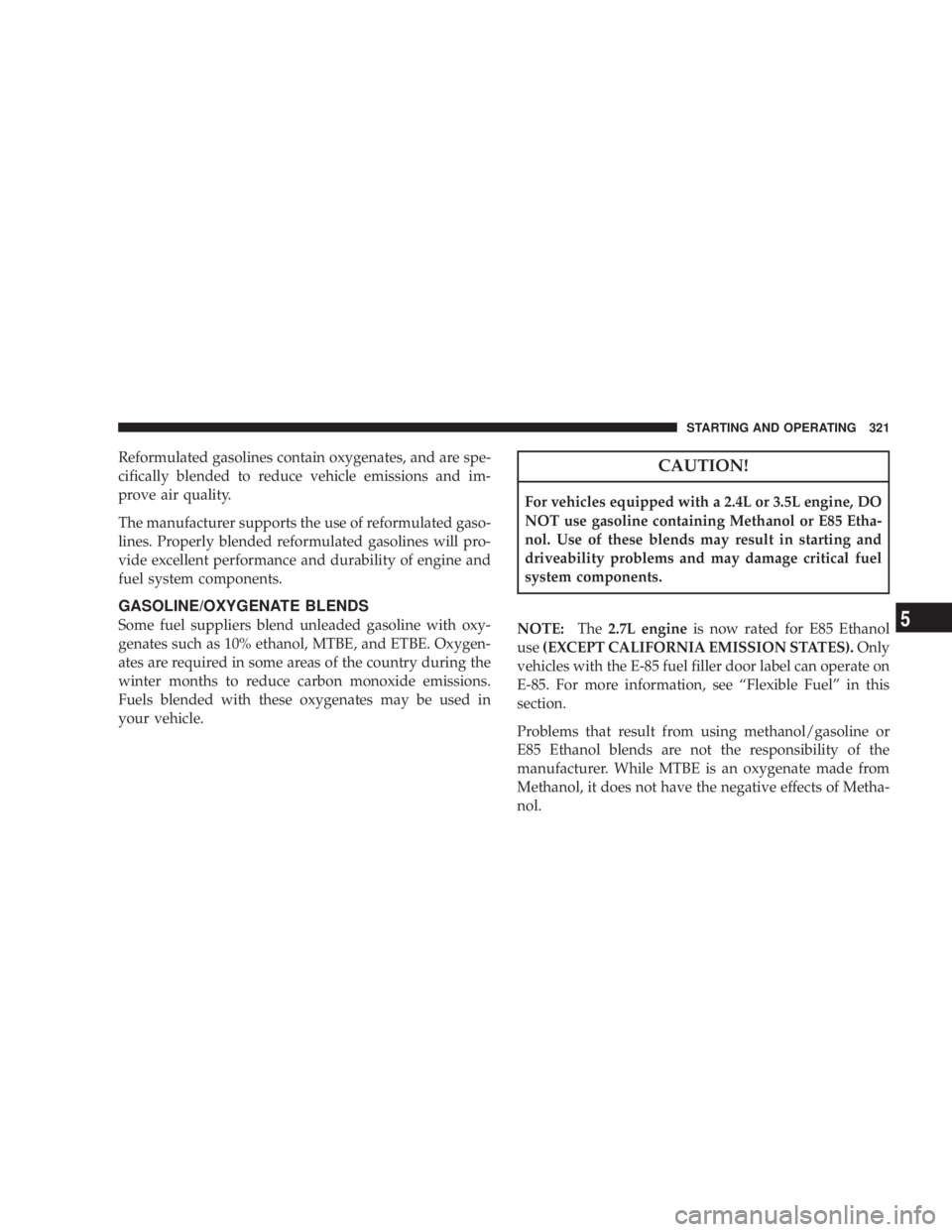
Reformulated gasolines contain oxygenates, and are spe-
cifically blended to reduce vehicle emissions and im-
prove air quality.
The manufacturer supports the use of reformulated gaso-
lines. Properly blended reformulated gasolines will pro-
vide excellent performance and durability of engine and
fuel system components.
GASOLINE/OXYGENATE BLENDS
Some fuel suppliers blend unleaded gasoline with oxy-
genates such as 10% ethanol, MTBE, and ETBE. Oxygen-
ates are required in some areas of the country during the
winter months to reduce carbon monoxide emissions.
Fuels blended with these oxygenates may be used in
your vehicle. CAUTION!For vehicles equipped with a 2.4L or 3.5L engine, DO
NOT use gasoline containing Methanol or E85 Etha-
nol. Use of these blends may result in starting and
driveability problems and may damage critical fuel
system components.
NOTE: The 2.7L engine is now rated for E85 Ethanol
use (EXCEPT CALIFORNIA EMISSION STATES). Only
vehicles with the E-85 fuel filler door label can operate on
E-85. For more information, see ªFlexible Fuelº in this
section.
Problems that result from using methanol/gasoline or
E85 Ethanol blends are not the responsibility of the
manufacturer. While MTBE is an oxygenate made from
Methanol, it does not have the negative effects of Metha-
nol. STARTING AND OPERATING 321
5
Page 324 of 467
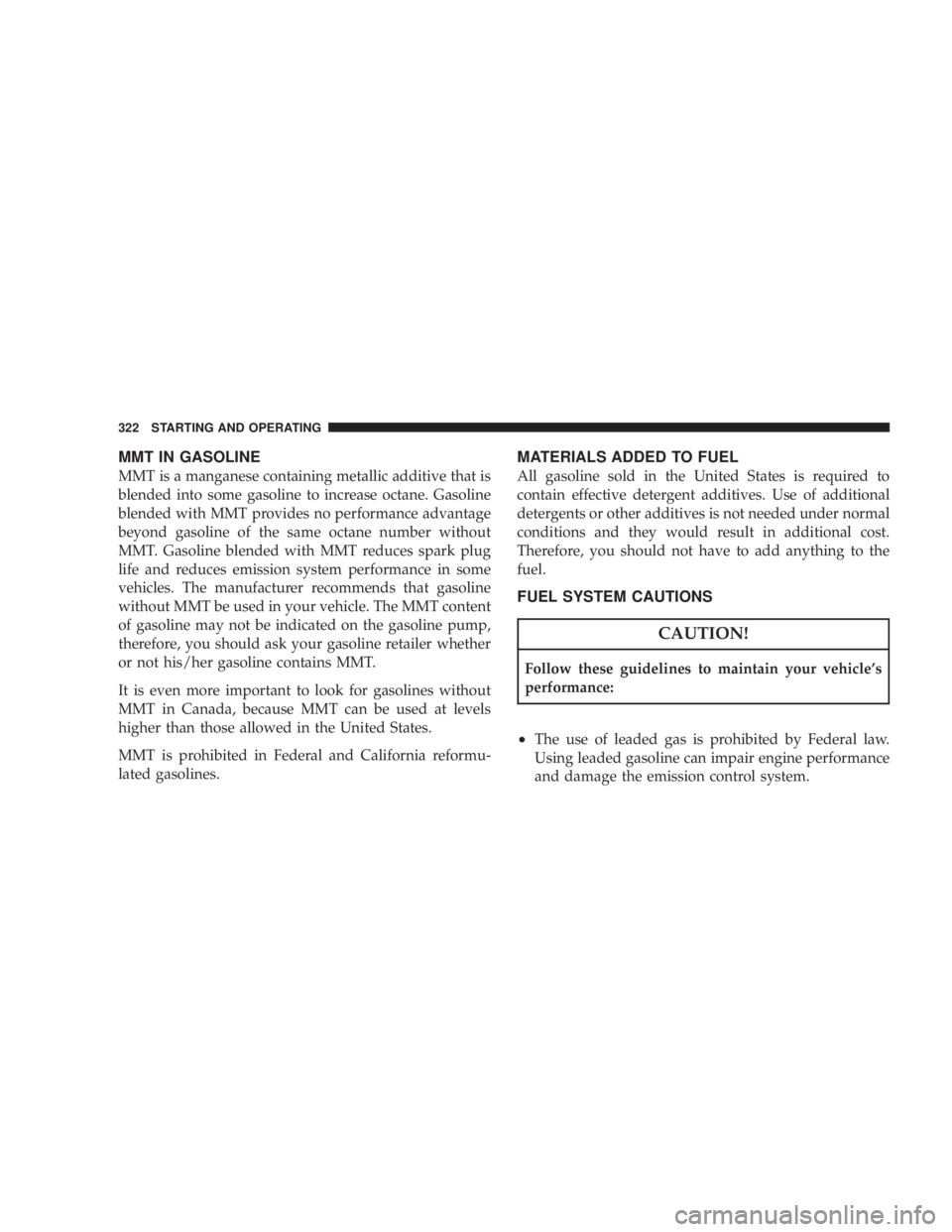
MMT IN GASOLINE
MMT is a manganese containing metallic additive that is
blended into some gasoline to increase octane. Gasoline
blended with MMT provides no performance advantage
beyond gasoline of the same octane number without
MMT. Gasoline blended with MMT reduces spark plug
life and reduces emission system performance in some
vehicles. The manufacturer recommends that gasoline
without MMT be used in your vehicle. The MMT content
of gasoline may not be indicated on the gasoline pump,
therefore, you should ask your gasoline retailer whether
or not his/her gasoline contains MMT.
It is even more important to look for gasolines without
MMT in Canada, because MMT can be used at levels
higher than those allowed in the United States.
MMT is prohibited in Federal and California reformu-
lated gasolines. MATERIALS ADDED TO FUEL
All gasoline sold in the United States is required to
contain effective detergent additives. Use of additional
detergents or other additives is not needed under normal
conditions and they would result in additional cost.
Therefore, you should not have to add anything to the
fuel.
FUEL SYSTEM CAUTIONS
CAUTION!Follow these guidelines to maintain your vehicle's
performance:
² The use of leaded gas is prohibited by Federal law.
Using leaded gasoline can impair engine performance
and damage the emission control system.322 STARTING AND OPERATING